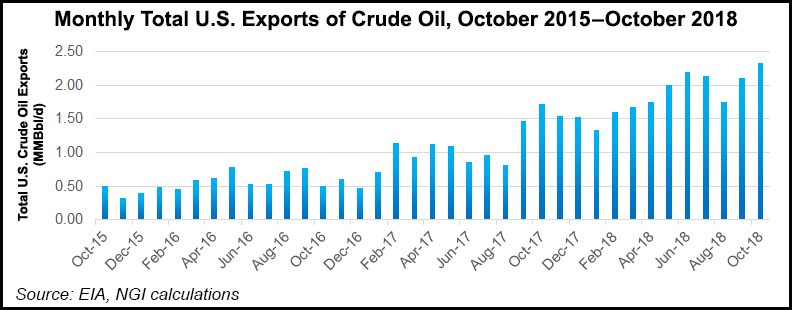Infrastructure | NGI All News Access | NGI The Weekly Gas Market Report
South Texas VLCC Project to Export Oil Gains Momentum as $92M Contract Awarded
As midstream companies like Enbridge Inc. begin racing to develop deepwater export terminals along the Gulf Coast to accommodate very large crude carriers (VLCC), federal authorities have upped their efforts to deepen the country’s largest export port as the U.S. Army Corps of Engineers awarded its first contract last week for the Corpus Christi Ship Channel Improvement Project.

Illinois-based Great Lakes Dredge and Dock Corp., which also worked on clean-up efforts following the 2010 Macondo blowout in the deepwater Gulf of Mexico, said dredging to deepen the entrance channel will begin during the second quarter, with completion expected in early 2020.
The overall ship channel deepening effort — with an estimated contract value of around $360 million — will be done in multiple phases, competitively bid and worked over the next five years.
The project is sponsored by the Corps’ Galveston District, working in partnership with the Port of Corpus Christi to fund the work. In November, Corps earmarked an additional $59 million for the South Texas project in its fiscal year 2019 work plan, bringing total federal appropriations to $95 million.
“The award of this first dredging contract is without a doubt the most important development we will see in 2019,” Port Chairman Charles W. Zahn said. “Building critical infrastructure for the energy sector is our primary mission and will allow larger vessels access to much needed export facilities, safely and responsibly.”
This project is one of four capital deepening projects that Great Lakes plans to construct during 2019. Three additional contracts are planned to create much-needed deepwater access to the Corpus port.
“This complex deepening work is well suited to our proven experience in this type of project, including our expertise in minimizing the environmental impact of our projects on the natural habitats of the work areas,” Great Lakes CEO Lasse Petterson said.
The company’s dredging operations include using hopper and cutter suction dredges to excavate more than 6.6 million cubic yards of dense sands and clays to a depth of 58 feet.
The deepening of the ship channel comes as midstreamers that include Enbridge and Trafigura Group Pte Ltd. seek to expand U.S. oil exports with new terminal projects, while operators with existing VLCC-capable assets “turned up the volume” in a major way last month.
The Louisiana Offshore Oil Port, or LOOP, off Port Fourchon, LA, is the only existing terminal that can fully load a VLCC in one fell swoop. Last February, the LOOP launched its export program as it loaded a supertanker destined for China.
In December, the LOOP showed off new upgrades by loading three supertankers — about 6 million bbl of crude total — in a matter of only seven days, according to RBN Energy.
“That’s impressive — it had never been done before — but companies like Enterprise Products Partners LP have indicated that their planned offshore terminals will be capable of more than doubling that pace — to as many as seven supertankers in a week’s time,” RBN analyst Laura Blewitt said in a recent blog post.
Meanwhile, the export hub in Ingleside, TX, in the northeast corner of the Port of Corpus Christi, can partially load a VLCC, as can the Seaway export hub, a joint development between Enbridge and Enterprise.
“We expect these incremental improvements to hasten the pace of U.S. crude exports in 2019. This year, what we’re looking forward to the most is finding out which new projects will advance” via final investment decisions “and how quickly they can be brought online,” Blewitt said.
© 2024 Natural Gas Intelligence. All rights reserved.
ISSN © 2577-9877 | ISSN © 1532-1266 | ISSN © 2158-8023 |
